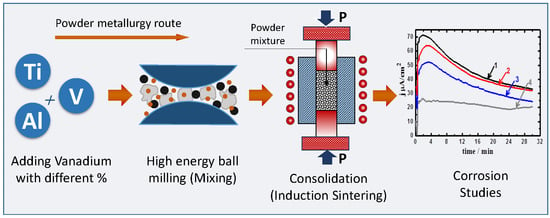Role of Vanadium Additions on the Corrosion Mitigation of Ti-6Al-xV Alloy in Simulated Body Fluid
Abstract
1. Introduction
2. Materials and Methods
2.1. Chemicals, Materials, and Fabrication of Ti-6Al-xV Alloys
2.2. Electrochemical Experiments
2.3. Characterization Techniques
3. Results and Discussion
3.1. XRD Patterns
3.2. Cyclic Potentiodynamic Polarization (CPP) Data
3.3. EIS Data
3.4. Chronoamperometry
3.5. Surface Examinations
4. Conclusions
Author Contributions
Funding
Conflicts of Interest
References
- Zhang, H.; Kou, H.; Yang, J.; Huang, D.; Nan, H.; Li, J. Microstructure evolution and tensile properties of Ti-6.5Al-2Zr-Mo-V alloy processed with thermo hydrogen treatment. Mater. Sci. Eng. A 2014, 619, 274–280. [Google Scholar] [CrossRef]
- Simka, W.; Sadkowski, A.; Warczak, M.; Iwaniak, A.; Dercz, G.; Michalska, J.; MacIej, A. Characterization of passive films formed on titanium during anodic oxidation. Electrochim. Acta 2011, 56, 8962–8968. [Google Scholar] [CrossRef]
- Pang, J.; Blackwood, D.J. Corrosion of titanium alloys in high temperature near anaerobic seawater. Corros. Sci. 2016, 105, 17–24. [Google Scholar] [CrossRef]
- Zhang, L.C.; Attar, H. Selective Laser Melting of Titanium Alloys and Titanium Matrix Composites for Biomedical Applications: A Review. Adv. Eng. Mater. 2016, 18, 463–475. [Google Scholar] [CrossRef]
- AlOtaibi, A.; Sherif, E.S.M.; Zinelis, S.; Al Jabbari, Y.S. Corrosion behavior of two cp titanium dental implants connected by cobalt chromium metal superstructure in artificial saliva and the influence of immersion time. Int. J. Electrochem. Sci. 2016, 11, 5877–5890. [Google Scholar] [CrossRef]
- Koizumi, H.; Takeuchi, Y.; Imai, H.; Kawai, T.; Yoneyama, T. Application of titanium and titanium alloys to fixed dental prostheses. J. Prosthodont. Res. 2019, 63, 266–270. [Google Scholar] [CrossRef]
- Sakaguchi, N.; Mitsuo, N.; Akahori, T.; Saito, T.; Furuta, T. Effects of alloying elements on elastic modulus of Ti-Nb-Ta-Zr system alloy for biomedical applications. Mater. Sci. Forum 2004, 449–452, 1269–1272. [Google Scholar] [CrossRef]
- He, G.; Hagiwara, M. Ti alloy design strategy for biomedical applications. Mater. Sci. Eng. C 2006, 26, 14–19. [Google Scholar] [CrossRef]
- Yu, S.Y.; Scully, J.R. Corrosion and Passivity of Ti-13% Nb-13% Zr in Comparison to Other Biomedical Implant Alloys. Corrosion 1997, 15, 965–976. [Google Scholar] [CrossRef]
- Ho, W.F. Effect of omega phase on mechanical properties of Ti-Mo alloys for biomedical applications. J. Med. Biol. Eng. 2008, 28, 47–51. [Google Scholar]
- Hussein, A.H.; Gepreel, M.A.H.; Gouda, M.K.; Hefnawy, A.M.; Kandil, S.H. Biocompatibility of new Ti-Nb-Ta base alloys. Mater. Sci. Eng. C 2016, 61, 574–578. [Google Scholar] [CrossRef] [PubMed]
- Khalil, K.A.; Sherif, E.S.M.; Nabawy, A.M.; Abdo, H.S.; Marzouk, W.W.; Alharbi, H.F. Titanium carbide nanofibers-reinforced aluminum compacts, a new strategy to enhance mechanical properties. Materials 2016, 9, 399. [Google Scholar] [CrossRef] [PubMed]
- da Silva, L.L.G.; Ueda, M.; Silva, M.M.; Codaro, E.N. Corrosion behavior of Ti-6Al-4V alloy treated by plasma immersion ion implantation process. Surf. Coat. Technol. 2007, 201, 8136–8139. [Google Scholar] [CrossRef]
- Ahn, H.; Lee, D.; Lee, K.M.; Lee, K.; Baek, D.; Park, S.W. Oxidation behavior and corrosion resistance of Ti-10Ta-10Nb alloy. Surf. Coat. Technol. 2008, 202, 5784–5789. [Google Scholar] [CrossRef]
- Erinosho, M.F.; Akinlabi, E.T.; Pityana, S. Microstructure and Corrosion Behaviour of Laser Metal Deposited Ti6Al4V/Cu Composites in 3.5% Sea Water. Mater. Today Proc. 2015, 2, 1166–1174. [Google Scholar] [CrossRef]
- Niinomi, M. Recent metallic materials for biomedical applications. Metall. Mater. Trans. A 2002, 33, 477. [Google Scholar] [CrossRef]
- Bangera, M.; D’Costa, V. Titanium and its alloys: Properties and applications for use as an oral biomaterial: A review. J. Res. Dent. 2015, 3, 592–599. [Google Scholar] [CrossRef][Green Version]
- Hrabe, N.; Quinn, T. Effects of processing on microstructure and mechanical properties of a titanium alloy (Ti-6Al-4V) fabricated using electron beam melting (EBM), part 1: Distance from build plate and part size. Mater. Sci. Eng. A 2013, 573, 264–270. [Google Scholar] [CrossRef]
- Hrabe, N.; Quinn, T. Effects of processing on microstructure and mechanical properties of a titanium alloy (Ti-6Al-4V) fabricated using electron beam melting (EBM), part 2: Energy input, orientation, and location. Mater. Sci. Eng. A 2013, 573, 271–277. [Google Scholar] [CrossRef]
- Mogoda, A.S.; Ahmad, Y.H.; Badawy, W.A. Corrosion behaviour of Ti-6Al-4V alloy in concentrated hydrochloric and sulphuric acids. J. Appl. Electrochem. 2004, 34, 873–878. [Google Scholar] [CrossRef]
- Geetha, M.; Singh, A.K.; Asokamani, R.; Gogia, A.K. Ti based biomaterials, the ultimate choice for orthopaedic implants - A review. Prog. Mater. Sci. 2009, 54, 397–425. [Google Scholar] [CrossRef]
- Beck, T.R. Pitting of Titanium: I. Titanium-Foil Experiments. J. Electrochem. Soc. 1973, 120, 1310–1316. [Google Scholar] [CrossRef]
- Kelly, J. Anodic Dissolution and Passivation of Titanium in Acidic Media: III. Chloride Solutions Eugene. J. Electrochem. Soc. 1979, 126, 2064–2075. [Google Scholar] [CrossRef]
- Riskin, I.V.; Torshin, V.B.; Skuratnik, Y.B.; Dembrovsky, M.A. Corrosion of Titanium by Cathodic Currents in Chloride Solutions. Corrosion 1984, 40, 266–271. [Google Scholar] [CrossRef]
- McKay, P.; Mitton, D.B. An Electrochemical Investigation of Localized Corrosion on Titanium in Chloride Environments. Corrosion 1985, 41, 52–62. [Google Scholar] [CrossRef]
- Patriona, M.M.; Müller, I.L. An electrochemical study of the crevice corrosion of titanium. J. Braz. Chem. Soc. 1997, 8, 137–142. [Google Scholar] [CrossRef]
- Long, M.; Rack, H.J. Titanium alloys in total joint replacement—A materials science perspective. Biomaterials 1998, 19, 1621–1639. [Google Scholar] [CrossRef]
- Leyens, C.; Peters, M. (Eds.) Titanium and Titanium Alloys; Wiley-VCH: Weinheim, Germany, 2004. [Google Scholar]
- Liu, X.; Chu, P.K.; Ding, C. Surface modification of titanium, titanium alloys, and related materials for biomedical applications. Mater. Sci. Eng. R 2004, 47, 49–121. [Google Scholar] [CrossRef]
- Vera, M.L.; Linardi, E.; Lanzani, L.; Mendez, C.; Schvezov, C.E.; Ares, A.E. Corrosion resistance of titanium dioxide anodic coatings on Ti-6Al-4V. Mater. Corros. 2015, 66, 1140–1149. [Google Scholar] [CrossRef]
- Vera, M.L.; Ares, A.E.; Rosenberger, M.R.; Lamas, D.G.; Schvezov, C.E. Determination using X-ray reflectometry of the TiO2 coating’s thickness obtained by anodic oxidation. An. AFA 2009, 21, 174–178. [Google Scholar] [CrossRef]
- Velten, D.; Biehl, V.; Aubertin, F.; Valeske, B.; Possart, W.; Breme, J. Preparation of TiO2 layers on cp-Ti and Ti6Al4V by thermal and anodic oxidation and by sol-gel coating techniques and their characterization. J. Biomed. Mater. Res. 2002, 59, 18–28. [Google Scholar] [CrossRef] [PubMed]
- Diamanti, M.V.; Pedeferri, M.P. Effect of anodic oxidation parameters on the titanium oxides formation. Corros. Sci. 2007, 49, 939–948. [Google Scholar] [CrossRef]
- Chapala, P.; Sunil Kumar, P.; Joardar, J.; Bhandari, V.; Acharyya, S.G. Effect of alloying elements on the microstructure, coefficient of friction, in-vitro corrosion and antibacterial nature of selected Ti-Nb alloys. Appl. Surf. Sci. 2019, 469, 617–623. [Google Scholar] [CrossRef]
- Afzali, P.; Ghomashchi, R.; Oskouei, R.H. On the corrosion Behaviour of low modulus titanium alloys for medical implant applications: A review. Metals 2019, 9, 878. [Google Scholar] [CrossRef]
- Sherif, E.S.M.; Abdo, H.S.; Alharthi, N.H. Beneficial Effects of Vanadium Additions on the Corrosion of Ti6AlxV Alloys in Chloride Solutions. Metals 2020, 10, 264. [Google Scholar] [CrossRef]
- Sherif, E.S.M. Effects of exposure time on the anodic dissolution of Monel-400 in aerated stagnant sodium chloride solutions. J. Solid State Electrochem. 2012, 16, 891–899. [Google Scholar] [CrossRef]
- Latief, F.H.; Sherif, E.S.M.; Almajid, A.A.; Junaedi, H. Fabrication of exfoliated graphite nanoplatelets-reinforced aluminum composites and evaluating their mechanical properties and corrosion behavior. J. Anal. Appl. Pyrolysis 2011, 92, 485–492. [Google Scholar] [CrossRef]
- Alharthi, N.; Sherif, E.S.M.; Abdo, H.S.; El Abedin, S.Z. Effect of Nickel Content on the Corrosion Resistance of Iron-Nickel Alloys in Concentrated Hydrochloric Acid Pickling Solutions. Adv. Mater. Sci. Eng. 2017, 1893672, 1–8. [Google Scholar] [CrossRef]
- Sherif, E.S.M.; Potgieter, J.H.; Comins, J.D.; Cornish, L.; Olubambi, P.A.; Machio, C.N. The beneficial effect of ruthenium additions on the passivation of duplex stainless steel corrosion in sodium chloride solutions. Corros. Sci. 2009, 51, 1364–1371. [Google Scholar] [CrossRef]
- Badawy, W.A.; Al-Kharafi, F.M.; El-Azab, A.S. Electrochemical behaviour and corrosion inhibition of Al, Al-6061 and Al-Cu in neutral aqueous solutions. Corros. Sci. 1999, 41, 709–727. [Google Scholar] [CrossRef]
- Sherif, E.M.; Park, S.M. Effects of 1,4-naphthoquinone on aluminum corrosion in 0.50 M sodium chloride solutions. Electrochim. Acta 2006, 51, 1313–1321. [Google Scholar] [CrossRef]
- Mazhar, A.A.; Badawy, W.A.; Abou-Romia, M.M. Impedance studies of corrosion resistance of aluminium in chloride media. Surf. Coat. Technol. 1986, 29, 335–345. [Google Scholar] [CrossRef]
- Tomcsányi, L.; Varga, K.; Bartik, I.; Horányi, H.; Maleczki, E. Electrochemical study of the pitting corrosion of aluminium and its alloys-II. Study of the interaction of chloride ions with a passive film on aluminium and initiation of pitting corrosion. Electrochim. Acta 1989, 34, 855–859. [Google Scholar] [CrossRef]
- Rinner, M.; Gerlach, J.; Ensinger, W. Formation of titanium oxide films on titanium and Ti6A14V by O2-plasma immersion ion implantation. Surf. Coat. Technol. 2000, 132, 111–116. [Google Scholar] [CrossRef]
- Butt, A.; Hamlekhan, A.; Patel, S.; Royhman, D.; Sukotjo, C.; Mathew, M.T.; Shokuhfar, T.; Takoudis, C. A novel investigation of the formation of titanium oxide nanotubes on thermally formed oxide of Ti-6Al-4V. J. Oral Implantol. 2015, 41, 523–531. [Google Scholar] [CrossRef]
- Diamanti, M.V.; Bolzoni, F.; Ormellese, M.; Pérez-Rosales, E.A.; Pedeferri, M.P. Characterisation of titanium oxide films by potentiodynamic polarisation and electrochemical impedance spectroscopy. Corros. Eng. Sci. Technol. 2010, 45, 428–434. [Google Scholar] [CrossRef]
- Zhang, Z.; Chen, S.; Li, Y.; Li, S.; Wang, L. A study of the inhibition of iron corrosion by imidazole and its derivatives self-assembled films. Corros. Sci. 2009, 51, 291–300. [Google Scholar] [CrossRef]
- Orazem, M.E.; Tribollet, B. Electrochemical Impedance Spectroscopy, 1st ed.; John Wiley & Sons: Hoboken, NJ, USA, 2008. [Google Scholar]
- Oyane, A.; Kim, H.M.; Furuya, T.; Kokubo, T.; Miyazaki, T.; Nakamura, T. Preparation and assessment of revised simulated body fluids. J. Biomed. Mater. Res. A 2003, 65, 188–195. [Google Scholar] [CrossRef]
- Wall, F.D.; Martinez, M.A.; Vandenavyle, J.J. Relationship between induction time for pitting and pitting potential for high-purity aluminum. J. Electrochem. Soc. 2004, 151, 354–358. [Google Scholar] [CrossRef]
- Diggle, J.W.; Downie, T.C.; Goulding, C.W. The dissolution of porous oxide films on aluminium. Electrochim. Acta 1970, 15, 1079–1093. [Google Scholar] [CrossRef]

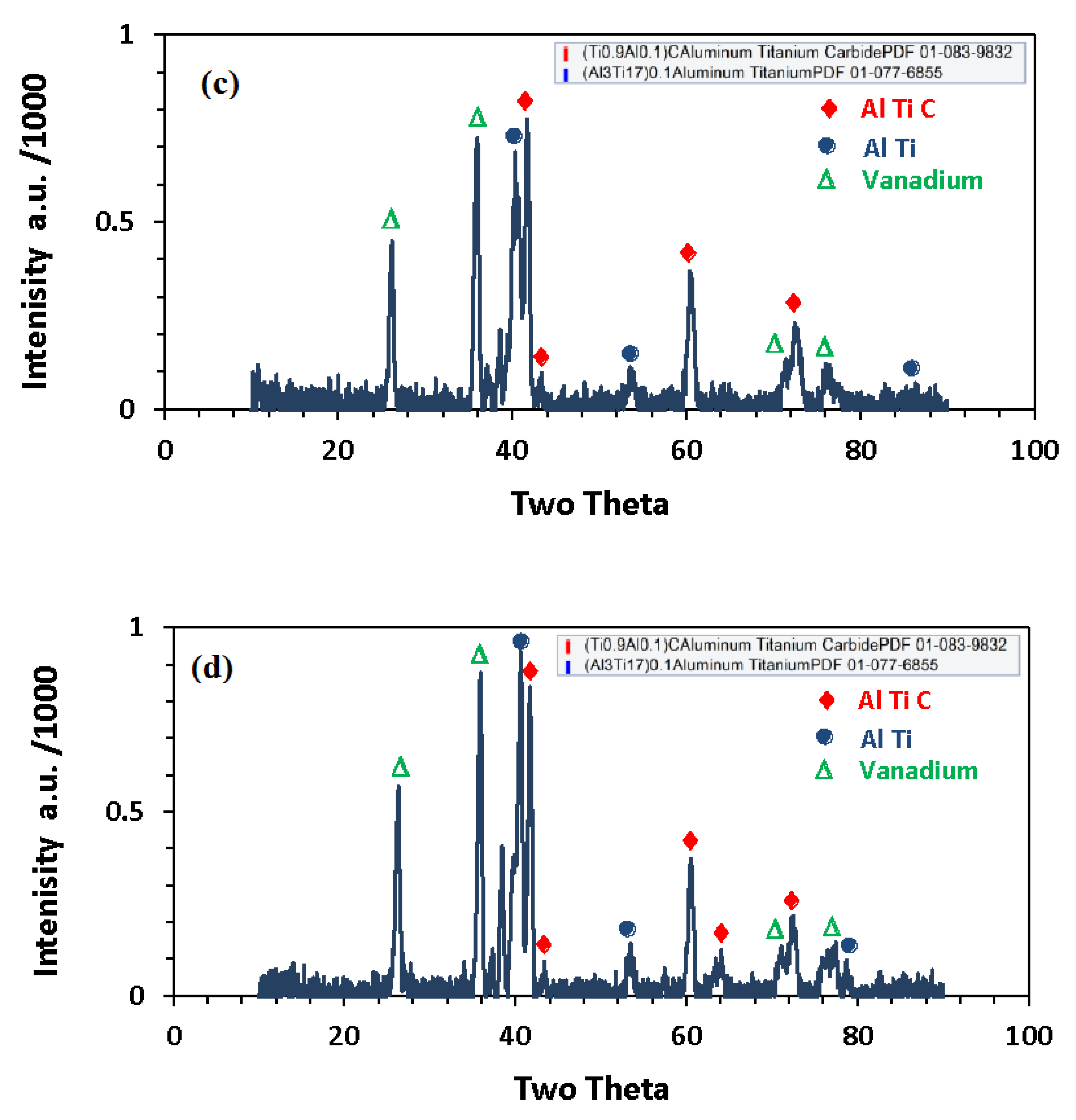
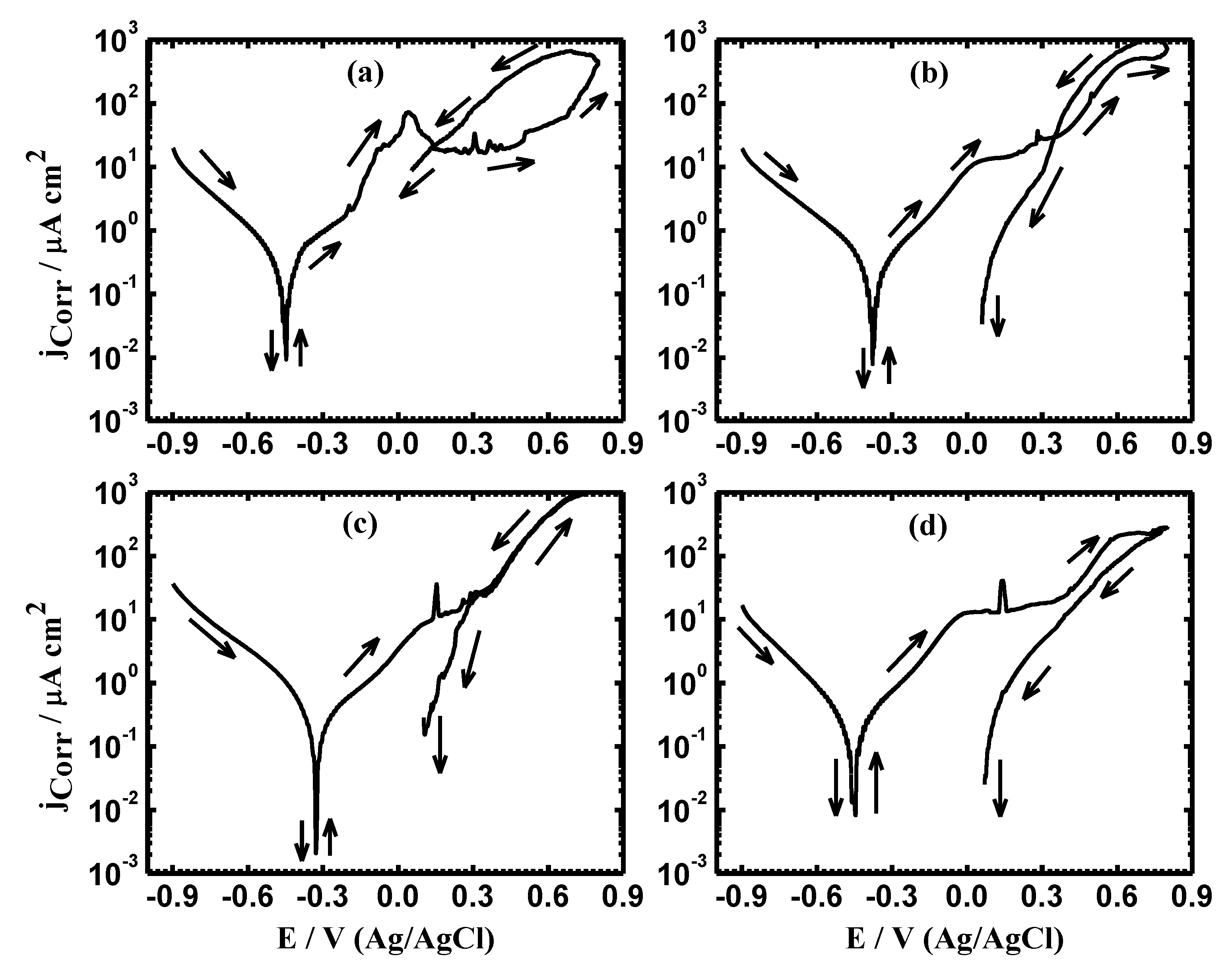
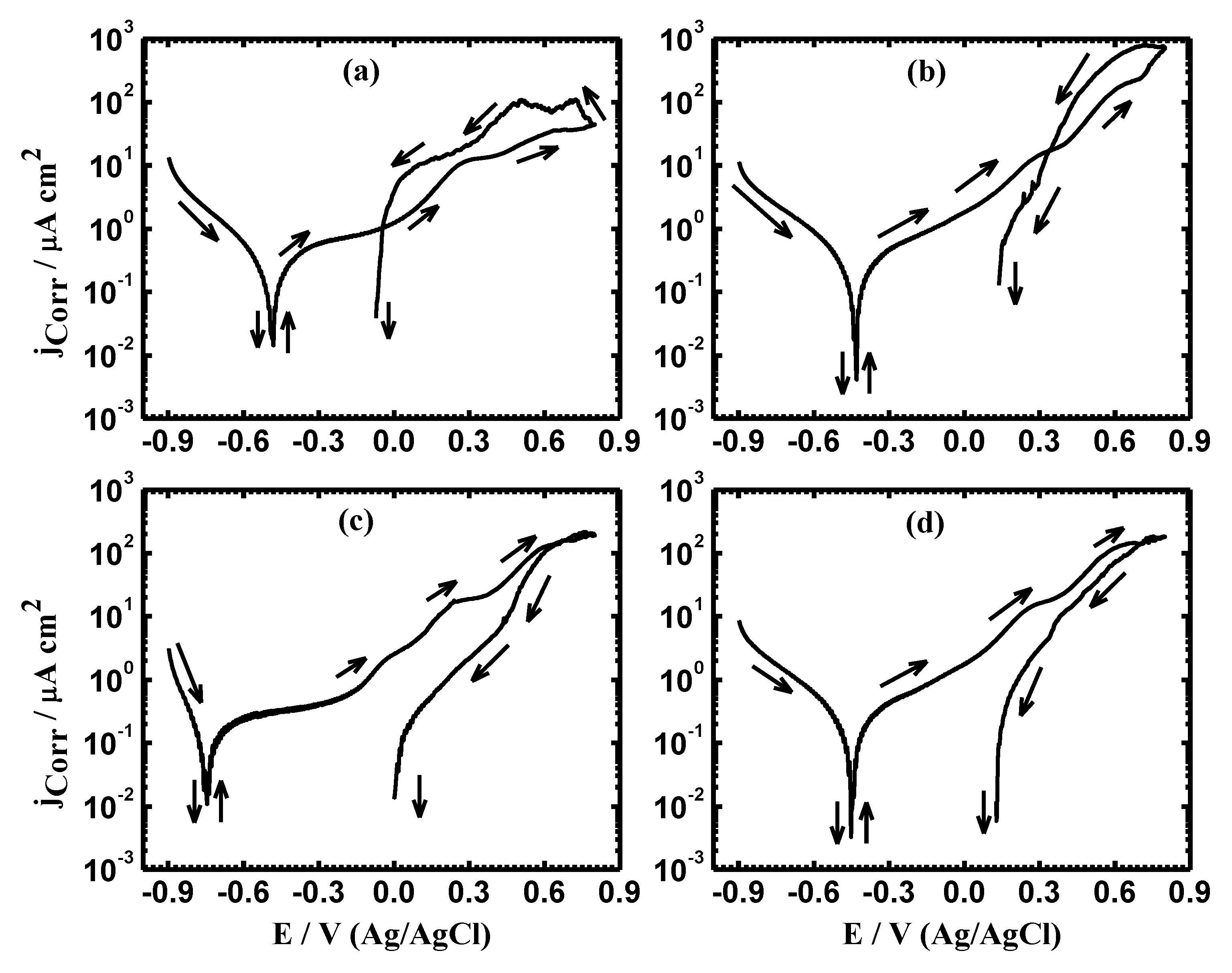
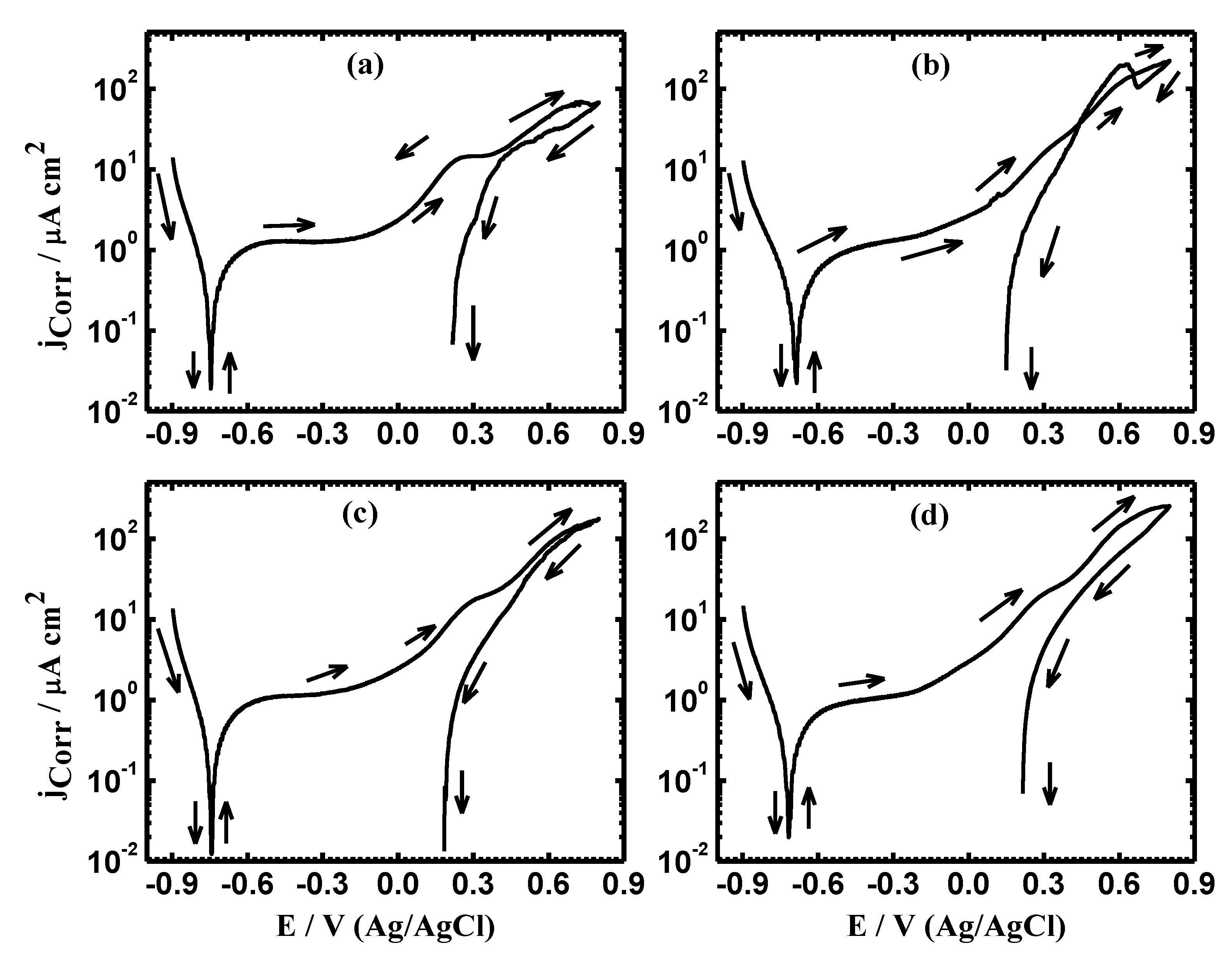
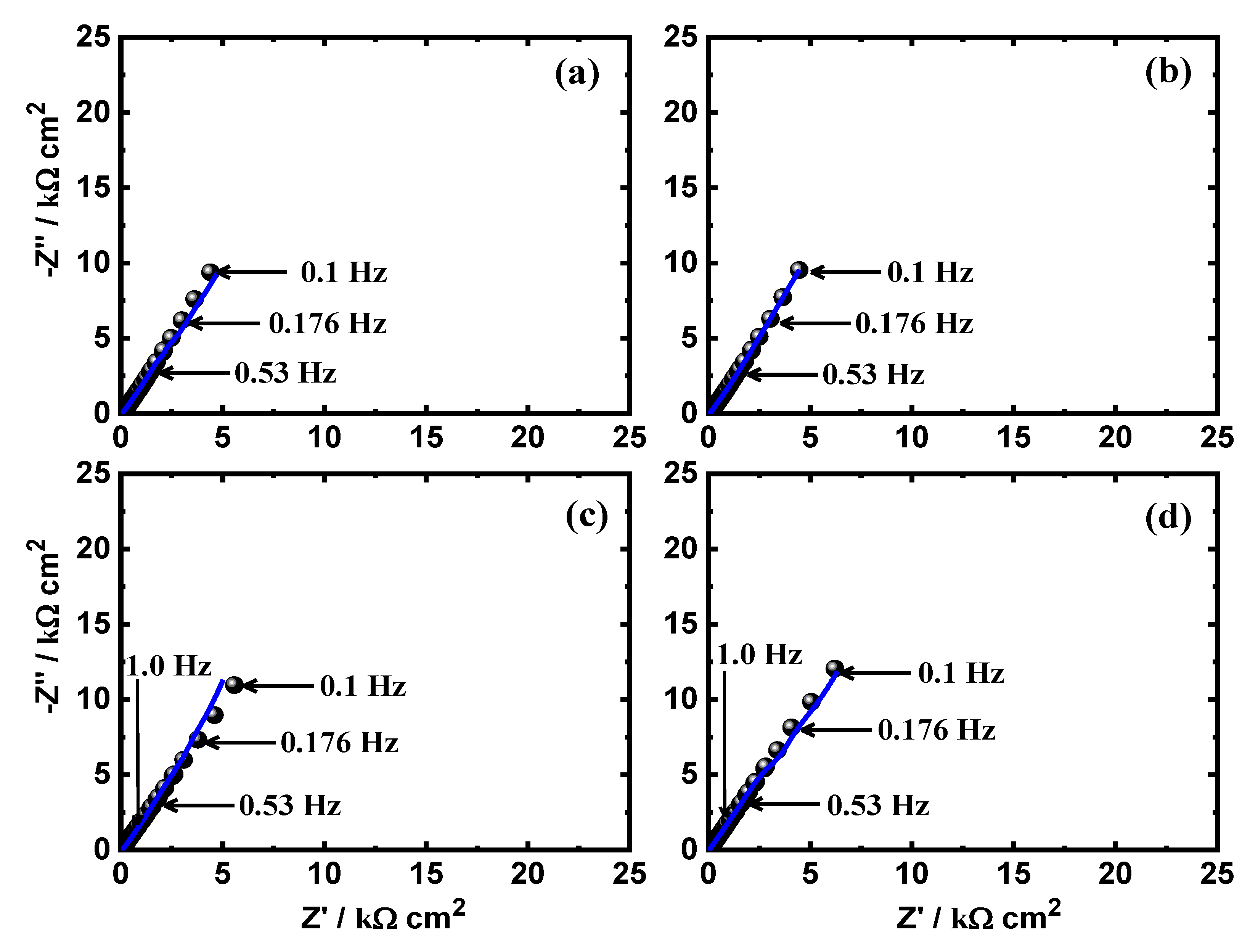
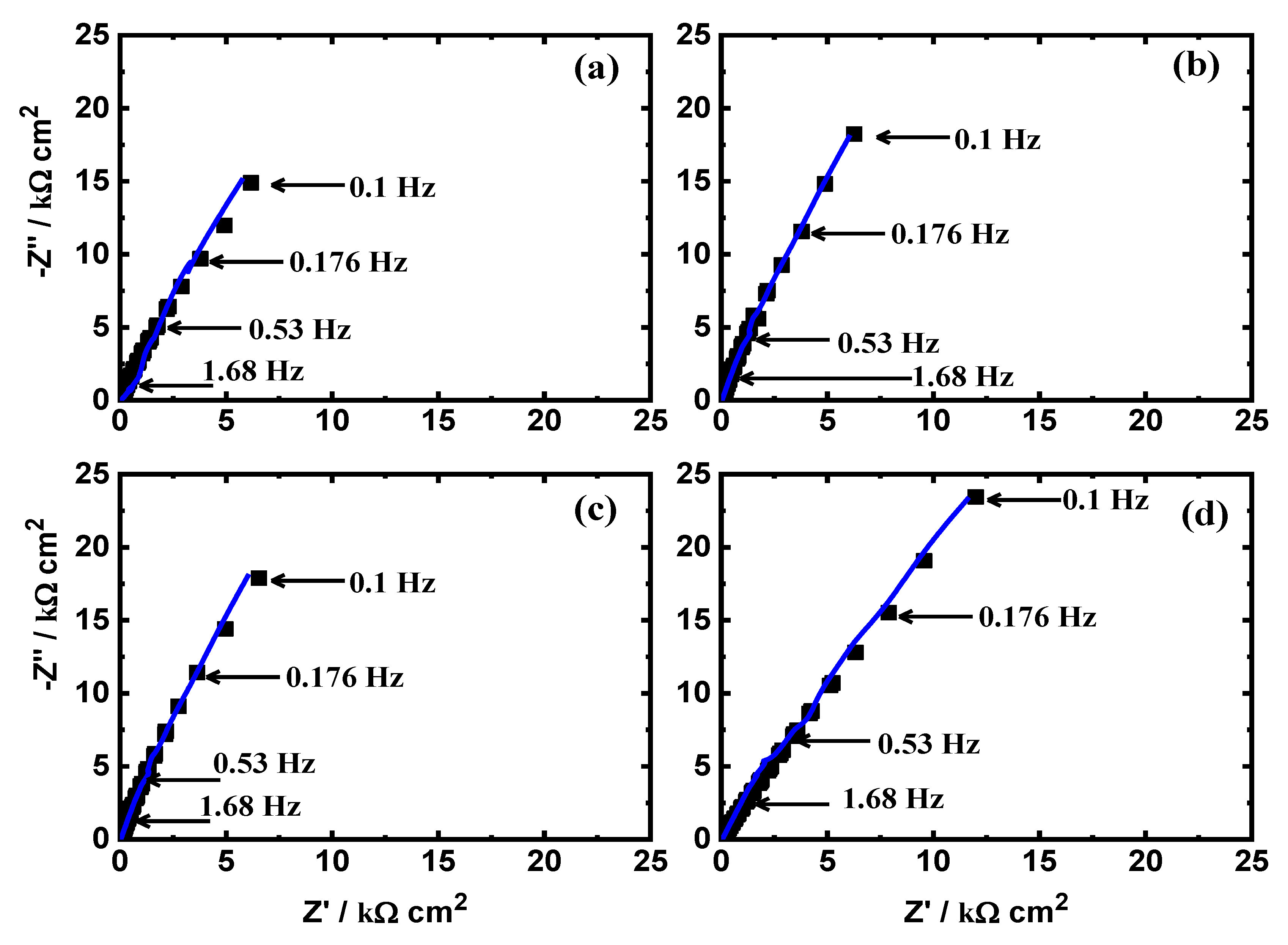
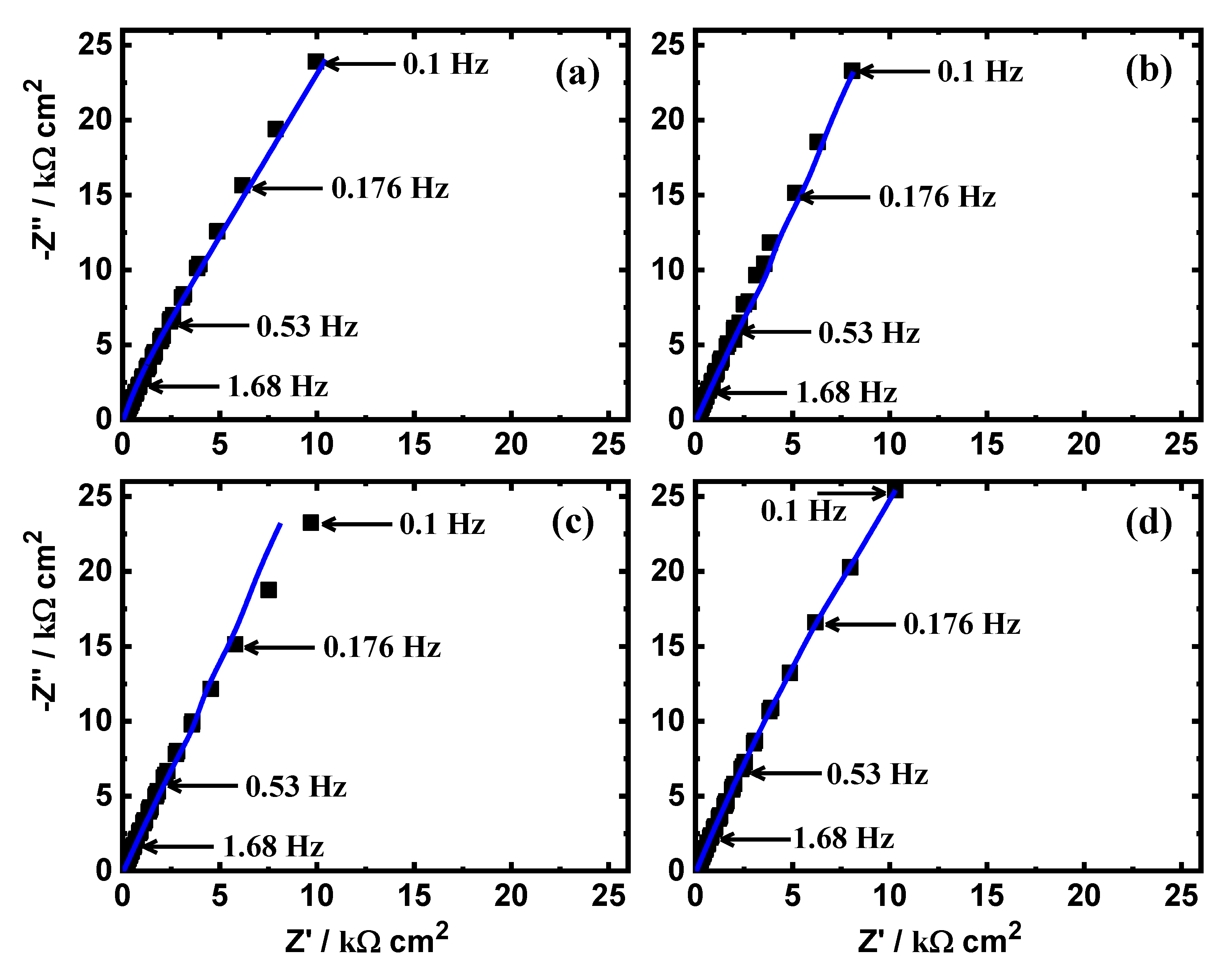
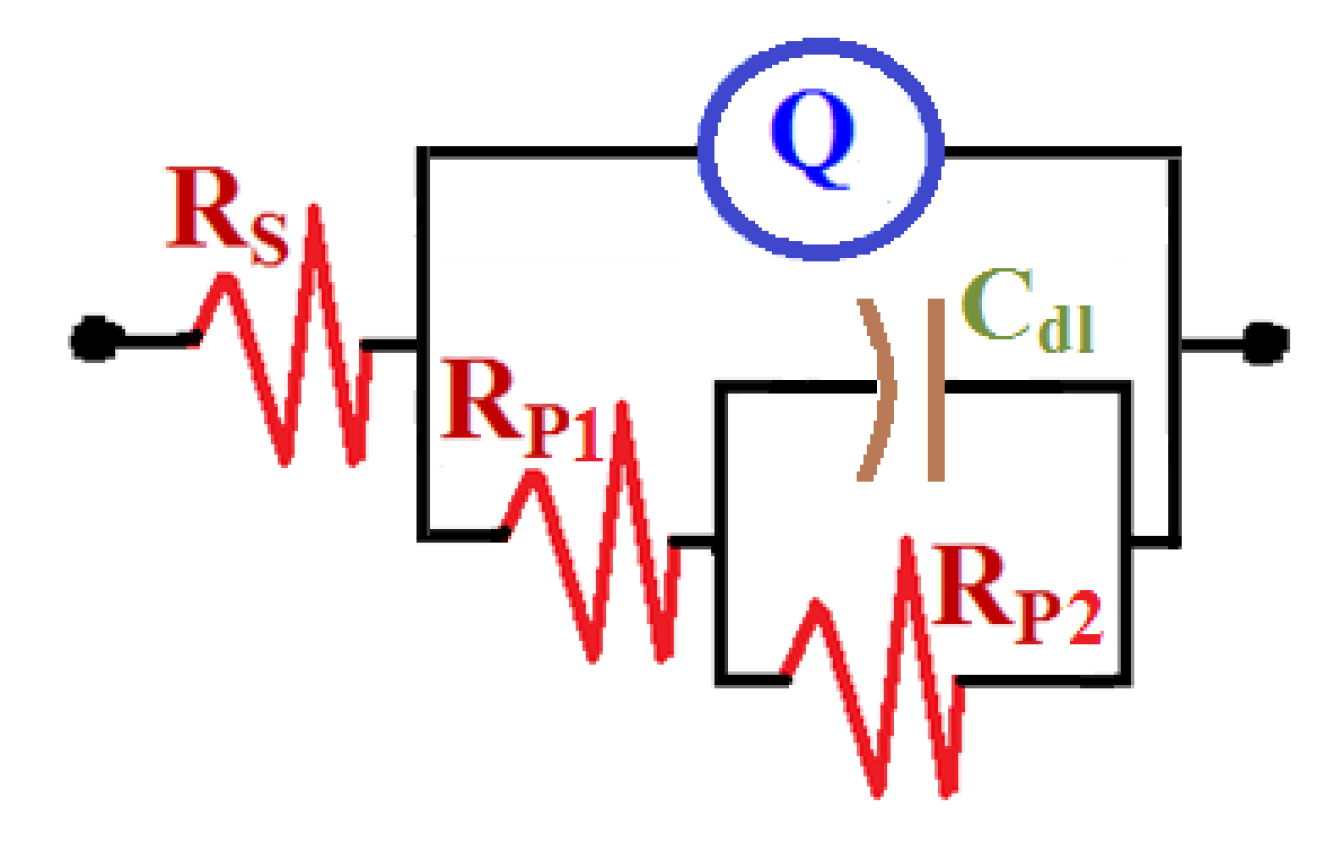

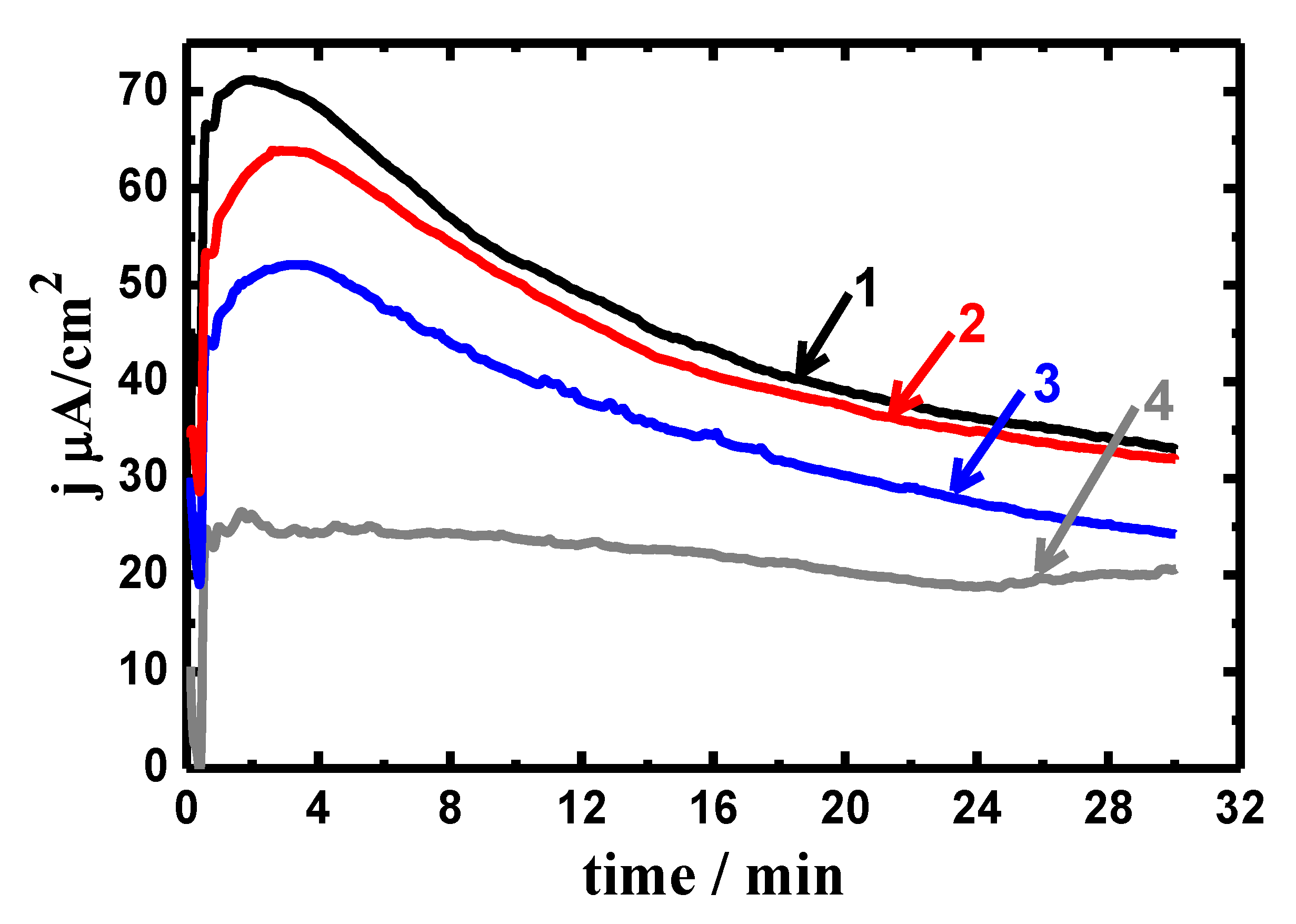
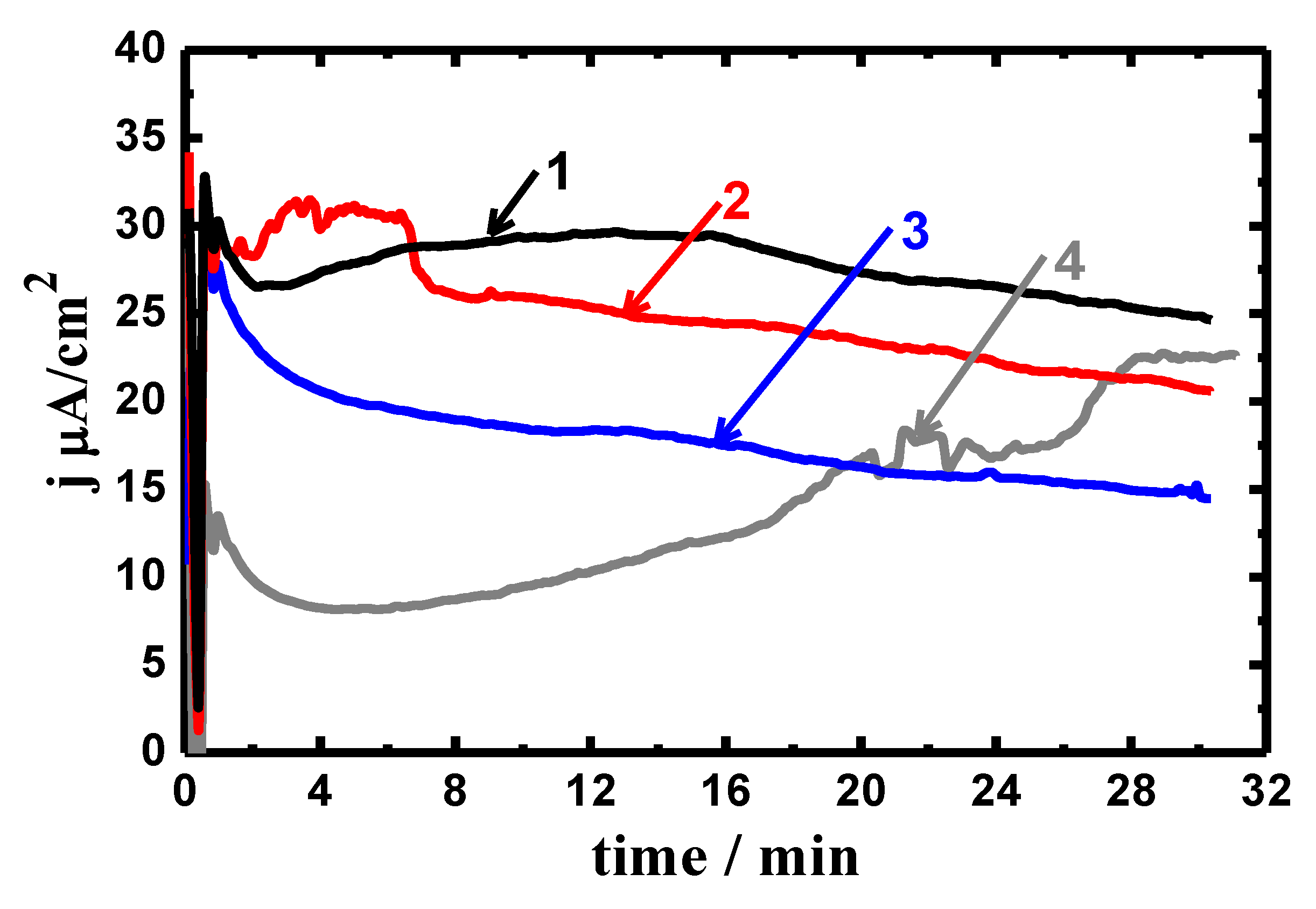


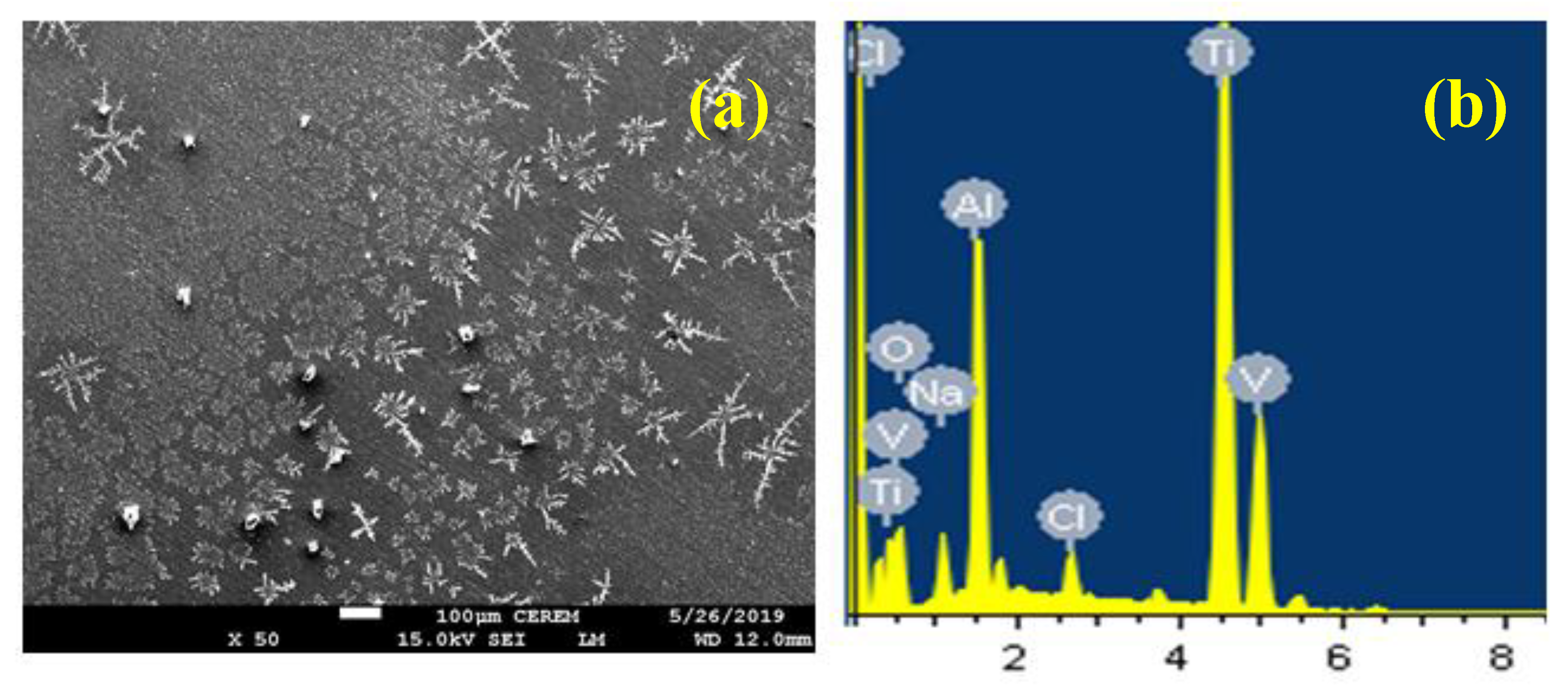
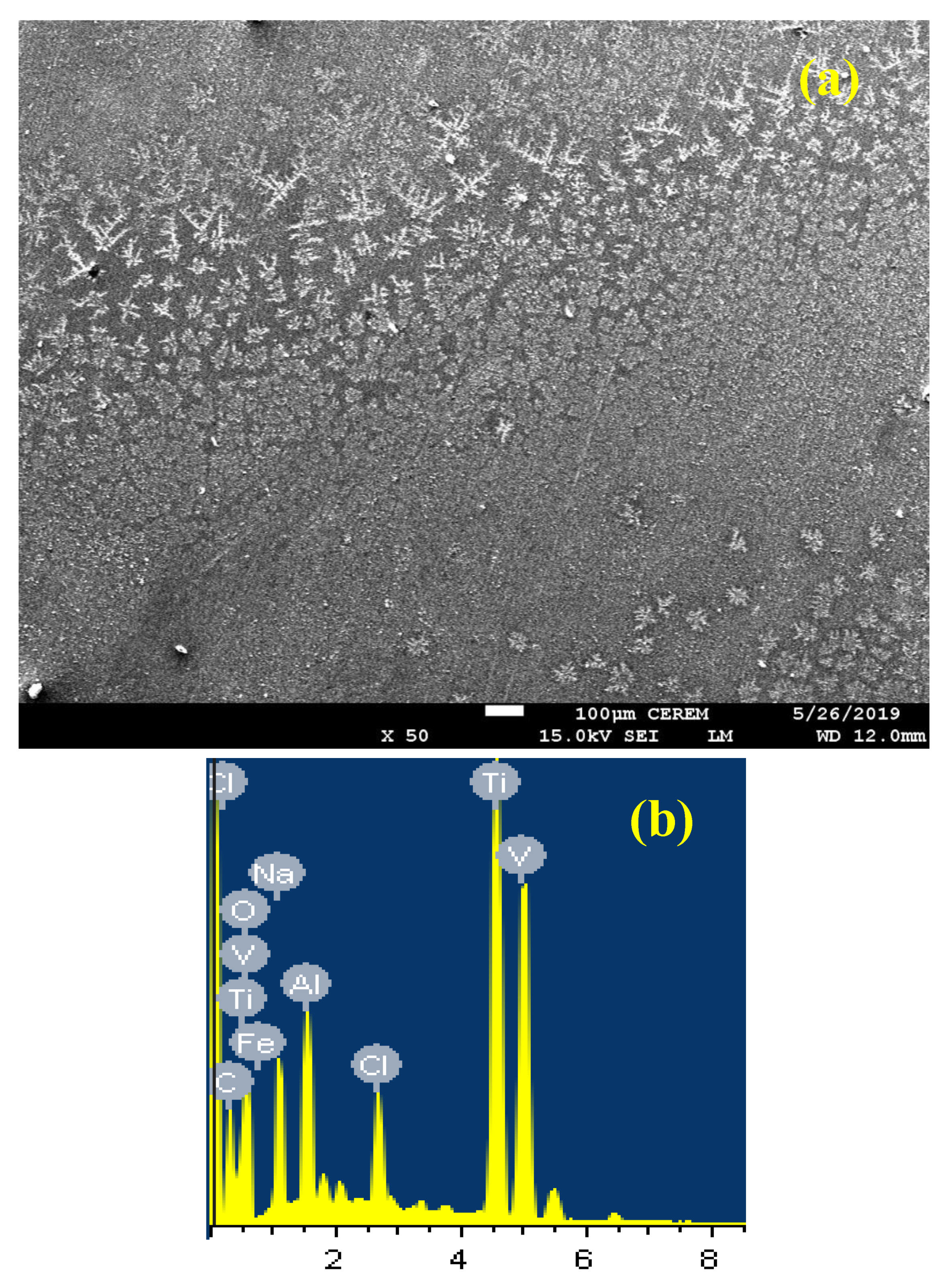
| Alloy | Parameter | |||||
|---|---|---|---|---|---|---|
| βc/ V/dec−1 | ECorr/V | βa/ V.dec−1 | jCorr/µA.cm−2 | *Rp/kΩ.cm2 | **RCorr/ mpy | |
| Ti-6%Al-2%V (1 h) | 0.105 | −0.740 | 0.120 | 0.40 | 60.9 | 0.00348 |
| Ti-6%Al-4%V (1 h) | 0.098 | −0.715 | 0.105 | 0.35 | 63.0 | 0.00305 |
| Ti-6%Al-6%V (1 h) | 0.092 | −0.705 | 0.108 | 0.27 | 80.0 | 0.00235 |
| Ti-6%Al-8%V (1 h) | 0.088 | −0.690 | 0.112 | 0.23 | 93.2 | 0.00200 |
| Ti-6%Al-2%V (24 h) | 0.112 | −0.495 | 0.105 | 0.25 | 94.3 | 0.00217 |
| Ti-6%Al-4%V (24 h) | 0.110 | −0.775 | 0.100 | 0.15 | 153.4 | 0.00131 |
| Ti-6%Al-6%V (24 h) | 0.100 | −0.455 | 0.095 | 0.13 | 162.9 | 0.00113 |
| Ti-6%Al-8%V (24 h) | 0.095 | −0.445 | 0.100 | 0.11 | 192.6 | 0.00096 |
| Ti-6%Al-2%V (48 h) | 0.115 | −0.455 | 0.090 | 0.13 | 168.9 | 0.00113 |
| Ti-6%Al-4%V (48 h) | 0.095 | −0.375 | 0.100 | 0.11 | 192.6 | 0.00096 |
| Ti-6%Al-6%V (48 h) | 0.088 | −0.345 | 0.095 | 0.10 | 198.6 | 0.00087 |
| Ti-6%Al-8%V (48 h) | 0.080 | −0.438 | 0.085 | 0.08 | 224.0 | 0.00070 |
| Alloy | Impedance data | ||||||
|---|---|---|---|---|---|---|---|
| RS/ Ω cm2 | Q | RP1/ Ω cm2 | Cdl/ μ Fcm−2 | RP2/ Ω cm2 | chi/ Sq. | ||
| YQ/ μ Fcm−2 | n | ||||||
| Ti-6%Al-2%V (1 h) | 43.6 ± 2 | 0.113 ± 0.01 | 0.69 ± 0.02 | 3377 ± 17 | 0.481 ± 0.01 | 5830 ± 15 | 0.1095 |
| Ti-6%Al-4%V (1 h) | 44.8 ± 2 | 0.132 ± 0.01 | 0.71 ± 0.02 | 5382 ± 20 | 0.438 ± 0.01 | 6300 ± 18 | 0.0509 |
| Ti-6%Al-6%V (1 h) | 45.9 ± 2 | 0.099 ± 0.01 | 0.75 ± 0.02 | 5856 ± 22 | 0.332 ± 0.01 | 7150 ± 20 | 0.0846 |
| Ti-6%Al-8%V (1 h) | 46.3 ± 2 | 0.093 ± 0.01 | 0.77 ± 0.02 | 6260 ± 18 | 0.194 ± 0.01 | 8610 ± 22 | 0.0758 |
| Ti-6%Al-2%V (24 h) | 44.8 ± 3 | 0.054 ± 0.01 | 0.78 ± 0.02 | 6130 ± 20 | 0.079 ± 0.01 | 7320 ± 26 | 0.0787 |
| Ti-6%Al-4%V (24 h) | 47.2 ± 3 | 0.053 ± 0.01 | 0.80 ± 0.02 | 7231 ± 22 | 0.063 ± 0.01 | 7607 ± 24 | 0.0715 |
| Ti-6%Al-6%V (24 h) | 47.1 ± 3 | 0.052 ± 0.01 | 0.82 ± 0.02 | 7378 ± 25 | 0.076 ± 0.01 | 8140 ± 23 | 0.0828 |
| Ti-6%Al-8%V (24 h) | 48.2 ± 3 | 0.051 ± 0.01 | 0.82 ± 0.02 | 8102 ± 28 | 0.057 ± 0.01 | 9320 ± 27 | 0.0965 |
| Ti-6%Al-2%V (48 h) | 47.5 ± 4 | 0.049 ± 0.01 | 0.83 ± 0.02 | 5539 ± 22 | 0.051 ± 0.01 | 11060 ± 25 | 0.1030 |
| Ti-6%Al-4%V (48 h) | 50.4 ± 4 | 0.047 ± 0.01 | 0.84 ± 0.02 | 7603 ± 26 | 0.046 ± 0.01 | 12080 ± 28 | 0.0694 |
| Ti-6%Al-6%V (48 h) | 48.1 ± 4 | 0.046 ± 0.01 | 0.85 ± 0.02 | 10147 ± 24 | 0.041 ± 0.01 | 12590 ± 34 | 0.0829 |
| Ti-6%Al-6%V (48 h) | 52.2 ± 4 | 0.042 ± 0.01 | 0.86 ± 0.02 | 10602 ± 30 | 0.039 ± 0.01 | 13070 ± 38 | 0.0709 |
© 2020 by the authors. Licensee MDPI, Basel, Switzerland. This article is an open access article distributed under the terms and conditions of the Creative Commons Attribution (CC BY) license (http://creativecommons.org/licenses/by/4.0/).
Share and Cite
Sherif, E.-S.M.; Ragab, S.A.; Abdo, H.S. Role of Vanadium Additions on the Corrosion Mitigation of Ti-6Al-xV Alloy in Simulated Body Fluid. Metals 2020, 10, 903. https://doi.org/10.3390/met10070903
Sherif E-SM, Ragab SA, Abdo HS. Role of Vanadium Additions on the Corrosion Mitigation of Ti-6Al-xV Alloy in Simulated Body Fluid. Metals. 2020; 10(7):903. https://doi.org/10.3390/met10070903
Chicago/Turabian StyleSherif, El-Sayed M., Sameh A. Ragab, and Hany S. Abdo. 2020. "Role of Vanadium Additions on the Corrosion Mitigation of Ti-6Al-xV Alloy in Simulated Body Fluid" Metals 10, no. 7: 903. https://doi.org/10.3390/met10070903
APA StyleSherif, E.-S. M., Ragab, S. A., & Abdo, H. S. (2020). Role of Vanadium Additions on the Corrosion Mitigation of Ti-6Al-xV Alloy in Simulated Body Fluid. Metals, 10(7), 903. https://doi.org/10.3390/met10070903






